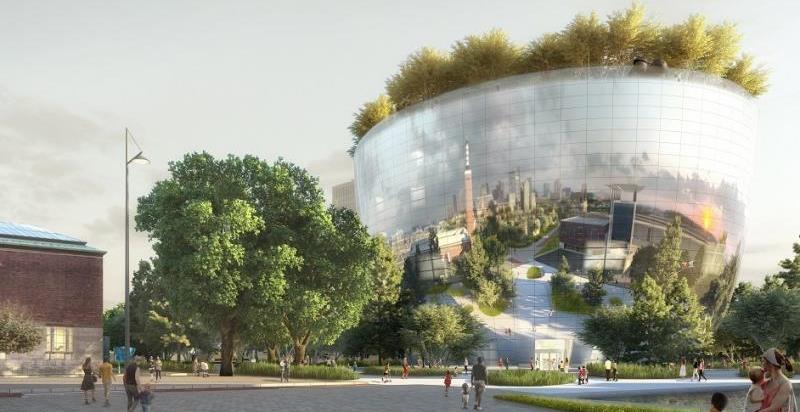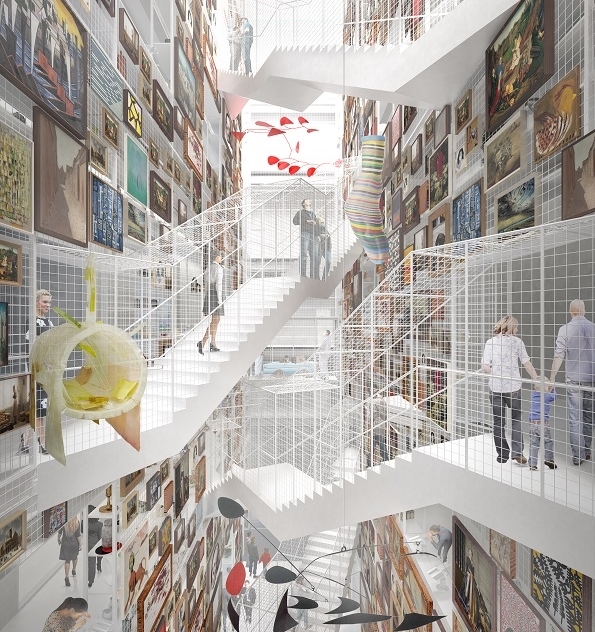
A Summons for Storage
The Dutch are pioneering hybrid models where storage facility is combined with the civic visibility of the public museum. Whilst claims are being made that private storage vaults constitute an elitist future for the museum, can Collectiegebouw Rotterdam and Stichting Onterfd Goed in Eindhoven keep museum collections in public reach?
Whilst municipal public collections across the western world have faced crippling cuts to their government funding, globalised private collectors and auction houses have flourished. In their wake the business of ‘Freeports’ has boomed– tax-free storage depots for the super-rich. These private museums apparently benefit from the largest collection of fine art in the world, but this rumour cannot be confirmed as the content of the stores is hidden to retain the security of the assets held [1]. Artworks in these storage depots benefit from reduced tax due to their assigned status ‘in transit’. The Freeport is a habitat well attuned to art as investment, as it can be exchanged between collectors and auction houses without having to move an inch. One thinks of storage as a period of rest, and while it is indeed a state of hibernation and preservation for the precious material, the Freeport’s fluidity accelerates it’s ability to work harder on a speculative level, moving across the market to accrue value. The oldest Freeport in Geneva was established to store wine, gold and other valuables but today it is art that provides the primary source of custom for the most recent Freeport initiatives in Singapore and Luxembourg. Artist commissions adorn the hallowed walls of these new storage facilities. They appear, from the few images available to be museum-like spaces for an elite audience of private collectors and art market professionals.
Rotterdam’s response to this exclusive enclosure of culture is a “publicly accessible art depot”[2]. A world first, het Collectiegebouw to be delivered by 2018 currently only exists in digitally rendered form. The plan is to invite private collectors to share their treasures alongside publicly held collections displayed on racks to provide a view into the storage life of an artwork. The project is potentially a successful example of public/ private collaboration, set to facilitate good relations between collectors and museums. Whilst in comparison the ‘Freeport’ feels like archaic separatism, perhaps it was only a matter of time before privately owned and stored art work became exposed to the twin politics of increasing transparency and the apparent rampant drive of the share economy to turn excess capacity of assets into a public service.
In a property climate where artists are struggling to hold onto a studio, I have been working for the past two years with artist and studio director Maurice Carlin to assist artists with storage. Regents Trading Estate, an emergency storage facility for contemporary artists in Salford, North-west England has formed one part of #temporarycustodians– an evolving conversation facilitated by Maurice and I concerning the ownership and visibility of cultural assets. Apophenia (2014) – an initial group exhibition within the store, allowed curatorial decisions to be made on the pragmatic basis of storage needs. Commissioned artists arranged their performances around artworks in various states of storage and semi-unboxing. The axiomatic meeting of works housed by #temporarycustodians based upon ‘need’ within our network relates to the seemingly irrefutable organisation of data combined on blogs and in databases. The removal of intellectualised authorship, if embraced on the display racks of Collectiegebouw could provide the liquidation of curatorial conceit. In the place of supposed enlightened intellectual conceit, ideological organising principles such as chronology and category that govern the infrastructures of both public and private institutions are exposed in the process of ‘radical openness’.

Owing to its globalised autonomy outside state jurisdiction, according to media theorist and artist Hito Steyerl the Freeport is “one of the most important art spaces in the world right now”. If it represents as Steyerl terms – “museum of the dark net” Stichting Onterfd Goed who employ crowd sourcing and social media might be the pubic facing museum for the internet age [3]. Stichting Onterfd Goed was established in 2012 by three entrepreneurs who found an opportunity in the dismantling of Scryption in 2011, a museum of the history of writing at Tilburg [4]. With many public collections suffering from severe government funding cuts, Stichting Onterfd Goed have established an affordable ‘adoption’ scheme for ‘orphaned’ artworks. Decentralising ownership by placing museum objects with individuals and non-museum organisations, the project aims to “de-institutionalize the care and ownership of heritage”[5]. In 2013 the process began when they invited proposals via Facebook and Twitter to house a collection of typewriters, belonging to the existentialist Dutch writer, Willem Frederik Hermans. The term ‘adoption’ is a technical word for ‘purchase’ facilitated by relatively flexible deaccessioning policies in the Netherlands, updated twice since 2000. The scheme has proved popular with the Dutch public and also won interest from COMCOL, The International Committee for Collecting and their European working group on ‘collection mobility’ . Know to promote mobility of collections by increasing efficiency of loaning through centralisation, Stichting Onterfd Goed moves beyond a rhetoric of ‘mobility’ of material holdings and towards full financial and decentralised liquidity.[6]
Here we see liquidity depart from acceleration or dematerialisation. Stichting Onterfd Goed reconnects publics with responsibility for their cultural assets, living with museum objects inviting a slowing down of material relation. While the #temporarycustodians project might be framed as a ‘meat-space’ manifestation of digital infrastructures, at het Collectiegebouw visitors are promised “live restorations” that transform the infrastructures of care for artworks into a tangible performative spectacle. Moving beyond a mere end-user experience, this could produce public awareness and interest in the entire ecology of an artwork’s material existence. The current offer of #temporarycustodians to store work in need of a home is based upon an excess property in the north of England and inflated prices in the south, seeking to acknowledge of the ecological material dependencies of artistic practice and their geographical specificity. Of course the Freeport asset benefits from specific identifiable placement in tax-free zoned territories. Despite the veiled financial speculation of Freeports and their attempts to disappear, in fact all the propositions toward liquid consumption rematerialise relations in specific territories in clear view.
EEN HERZIENE NEDERLANDSE VERTALING VAN DEZE TEKST IS GEPUBLICEERD IN METROPOLIS M No 4-2016 SHARING. NU IN DE WINKEL. OF BESTEL: [email protected]
Helen Kaplinsky


